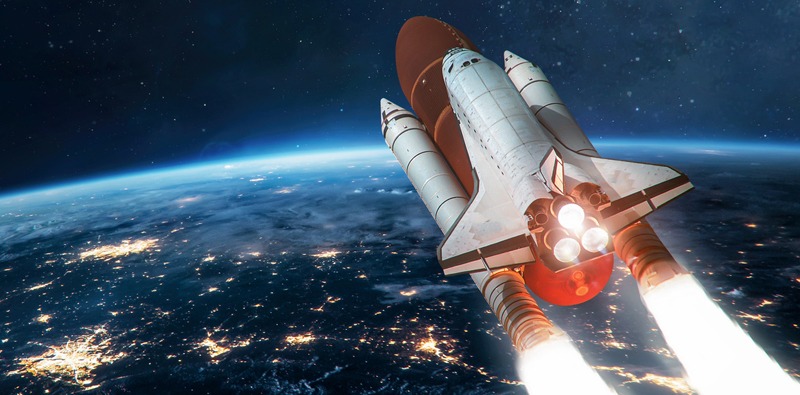The Space Shuttle Orbiter is the component of the Space Shuttle Spacecraft. It is a partially reusable orbital spacecraft system that was part of the abandoned Space Shuttle Program. It was operated by NASA, the US space agency, from 1977 to 2011. A Space Shuttle is a vehicle that can transport payloads and astronauts into low Earth orbit, conduct operations in space, and then re-enter the atmosphere. When it comes to landing back on Earth, it looks like a glider, returning the payload and crew onboard back to Earth.
Since then, six orbiters have been built for the flight: Atlantis, Discovery, Endeavor, Challenger, Columbia, and Enterprise. All these space shuttles were built in Palmdale, California, by Rockwell International based in Pittsburgh, PA. In 1977, the first orbiter, Enterprise, made its maiden flight. A non-motorized glider was carried by a modified Boeing 747 known as Shuttle Carrier Aircraft, and it was launched for a series of test flights and atmospheric landings.
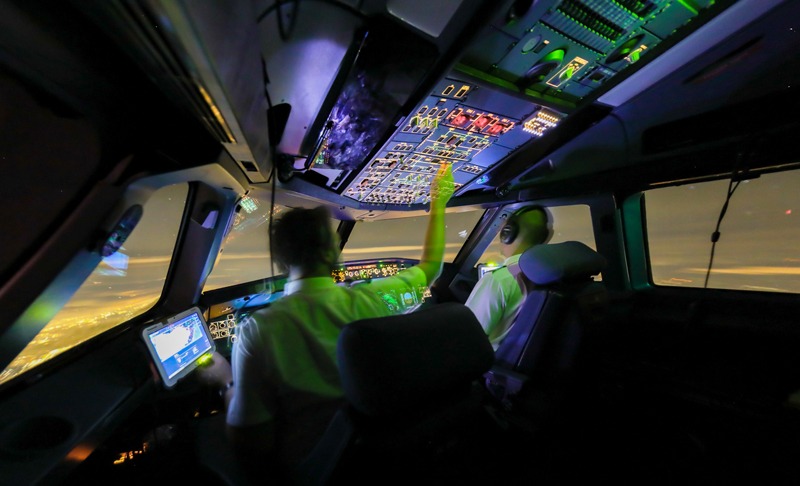
Pilots in cockpit
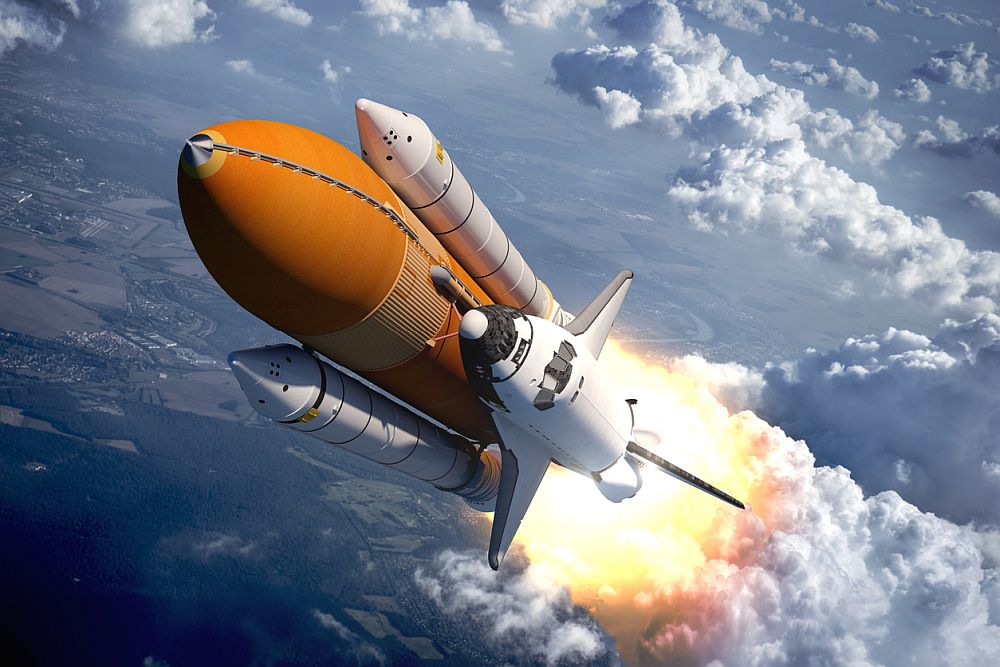
Space shuttle in space
History of Space Shuttle
The Space Shuttle was a low-earth orbital and partially reusable spacecraft system. It was operated by the National Aeronautics and Space Administration (NASA). The program’s official name was Space Transportation System (STS), taken from the plan of 1969 for a reusable spacecraft system. It was the only component funded for the development [1]. On the other hand, operational missions were launched with numerous satellites that conducted science experiments in orbit.
This program participated in constructing and maintaining the International Space Station (ISS). The first of four orbital test flights were held in 1981, which led to operational flights beginning in 1982. From 1981 to 2011, 134 missions were carried out [2]. All space shuttles were launched from the Florida Kennedy Space Center (KSC). During the period, the fleet record was 1,322 days, 19 hours, 21 minutes, and 23 seconds of flight time.
On the other hand, some of the statistics about the space shuttle program are as follows:
- The shuttle’s longest orbital flight was STS-80 at 17 days and 15 hours.
- The shuttle’s shortest flight was STS-51-L at 1 minute and 13 seconds. It was during the launch of Challenger but it broke. The O-ring was shrunk due to the cold morning on the right Solid Rocket Booster. It caused the external fuel tank to explode.
- The shuttles docked nine times at the Russian Mir space station while visiting the ISS 37 times.
- The highest altitude (apogee) reached by the shuttle was 386 miles (621 kilometers) during the launch of the Hubble Space Telescope.
- The program transported a total of 355 people representing 16 countries with a total of 852 shuttles.
- The Kennedy Space Center has served 78 missions as a landing site.
- 54 missions were landed at Edwards Air Force Base in California.
- Only 1 mission or space shuttle landed at White Sands, New Mexico.
First Orbiter
Enterprise was the first orbiter used for atmospheric flight testing. In the future, the plans were to upgrade the orbital capability, which was ultimately canceled. On the other hand, four fully operational orbiters were built:
- Atlantis
- Discovery
- Challenger
- Columbia
In 1986 and 2003, Challenger and Columbia were destroyed in the mission crashes, respectively. Sadly, 14 astronauts were killed in the crashing missions. In 1991, a fifth operational orbiter, Endeavor, was built to replace the Challenger. As a result, the space shuttle was withdrawn from service after the completion of STS-135 by Atlantis on 21 July 2011 [3].
| Space Shuttle | First Flight | Last Flight |
| Space Shuttle Enterprise | August 12, 1977 | October 26, 1977 |
| Space Shuttle Columbia | April 12-14, 1981 | January 16 – February 1, 2003 |
| Space Shuttle Atlantis | October 3 – 7, 1985 | July 8 – 21, 2011 |
| Space Shuttle Endeavour | May 7 – 16, 1992 | May 16 – June 1, 2011 |
Figure 1: Data by NASA [4] [5] [6] [7]
Components of the Space Shuttle
Orbiter
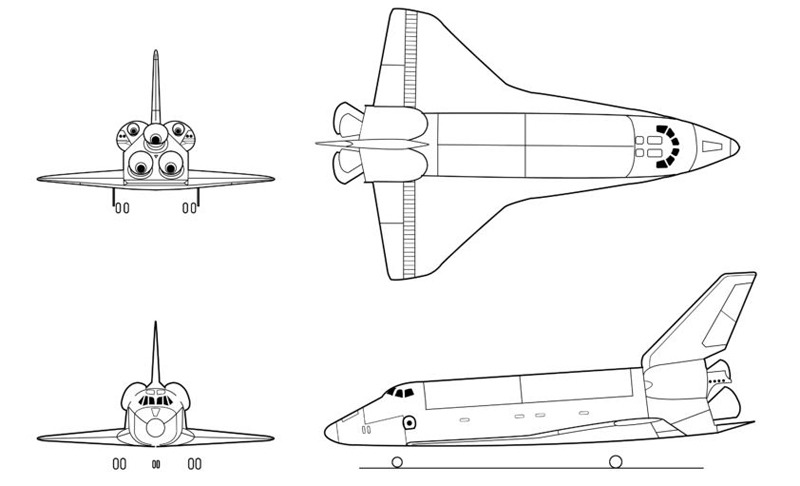
Also, it had an Orbital Maneuver System (OMS), which allowed the orbiter to modify, reach and come out of the orbit once in space. The double delta wings were 18m (60ft) long and swept 81° on the inside leading edge and 45° on the outside leading edge. Each wing had an internal and external elevon to provide control of flight during the re-entry. Also, a flap was located between the wings and under the engines to control the pitch of the orbiter.
The orbiter’s vertical stabilizer was reduced to 45° and contained a rudder that could be split to act as an aerodynamic brake. Also, the vertical stabilizer had a two-part drag parachute system, which helped reduce the orbiter’s speed before landing. The orbiter used retractable landing gear and two main landing gears, each with two tires. The main landing gear had two sets of brakes each. Also, the nose landing gear had electro-hydraulic steering gear.
Crew
The space shuttle crew varied depending on the mission. The test flights had only two members, the commander and the pilot. Both had piloting skills making them capable of flying and landing the orbiter. Mission specialists primarily carried out in-orbit operations, such as extravehicular activity (EVAs), payload deployment, and experiments. They were trained for the intended systems and missions.
At the beginning of the Space Shuttle program, NASA flew with payload specialists who knew about the orbiter’s systems. They worked for the company and were paid for the payload operations or deployment. Gregory B. Jarvis, a final payload specialist, flew STS-51-L, and the future non-pilots were assigned as mission specialists [9].
An astronaut flew as a manned space flight engineer on the STS-51-J and STS-51-C to serve as a military representative for the National Reconnaissance Office payload. STS-61-A was the only space shuttle with a crew of 8, but it was generally kept to 7 astronauts.
Payload Bay
The payload bay consists of the orbiter’s fuselage and provides cargo transport space for the Space Shuttle payloads. It was 18m (60ft) long and 4.6m (15ft) wide that could accommodate cylindrical payloads up to 4.6m in diameter. Two payload bay doors on each side of the bay provided a relatively tight seal to protect the payloads from heating during the launch and re-entry.
The payloads were secured in the hold at the spar attachment points. The cargo bay doors were radiators of the orbiter so that they were opened when they reached orbit for heat rejection [10]. The orbiter was capable of being used in conjunction with a variety of additional components such as:
- Laboratories.
- Boosters for launching payloads into space.
- The Remote Manipulator System (RMS).
- EDO Pallet for the extended mission durations.
External Tank
The Space Shuttle’s external tank (ET) carries the thruster for the main space shuttle engines. It connects the rocket’s solid thrusters with the orbiter. The ET was 47m (153.8ft) high and 8.4m (27.6ft) in diameter. ET contains separate reservoirs for liquid hydrogen (LH2) and liquid oxygen (LOX). The LOX tank was housed in the nose of the ET, which was 15m (49.3ft) high. On the other hand, LH2 comprised most of the ET, which was 29m (96.7ft) high.
The orbiter was attached to the ET on two umbilical plates containing two electrical umbilical plates and five thrusters, with forward and aft structural fittings. The exterior of the ET was covered with orange spray foam which helped it to survive the heat while launching and climbing [11].
Solid Rocket Booster
71.4% of the space shuttle’s thrust came from the Solid Rocket Boosters (SRBs) during takeoff and climb. They were the largest solid rocket engines ever used. Each SRB was 45m (149.2ft) high and 3.7m (12.2ft) wide. The solid rocket engines weighed 68,000 kg with a steel exterior of 13mm thick.
The sub-components of the SRB were the solid rocket engine, rocket nozzle, and forward cone. The propellant engine comprised most of the SRB chassis. The shell consisted of 11 steel sections comprising the SRB’s four main segments. The nose cone housed the forward separation engines and parachute systems. Also, the rocket nozzles could rotate up to 8° allowing the in-flight adjustments [12].
Shuttle Flights
Test Flights
The approach and landing test program consisted of 16 separate Enterprise tests covering the taxi tests, crewed and unmanned flights on the Shuttle Carrier Aircraft, and the free-flight tests. The following table contains free-flight tests and the orbiter’s free flight time. But the list does not include the total flight time, including the time spent in the air aboard the Boeing 747 Shuttle Carrier Aircraft (SCA) [13].
Order | Launch Date | Mission | Shuttle | Crew | Duration | Landing Site | Notes |
1 | 12 August, 1977 | ALT-12 | Enterprise | 2 | 00 h 05 m | Edwards | First Free Flight First Non-Captive Flight of Enterprise |
2 | 13 September, 1977 | ALT-13 | Enterprise | 2 | 00 h 05 m | Edwards | Second Free Flight |
3 | 23 September, 1977 | ALT-14 | Enterprise | 2 | 00 h 05 m | Edwards | Third Free Flight |
4 | 12 October, 1977 | ALT-15 | Enterprise | 2 | 00 h 02 m | Edwards | Fourth Free Flight First Flight Without -Operational Configuration |
5 | 26 October, 1977 | ALT-16 | Enterprise | 2 | 00 h 02 m | Edwards | Final Free Flight Final Non-Captive Flight of Enterprise |
Figure 2: Data by Spaceline.org [14]
| Crew 1 | |
| Position | Astronaut |
| Commander | Fred W. Haise, Jr. |
| Pilot | C. Gordon Fullerton |
Figure 3: Data by Spaceline.org [15]
| Crew 2 | |
| Position | Astronaut |
| Commander | Joseph H. Engle |
| Pilot | Richard H. Truly |
Figure 4: Data by Spaceline.org [16]
Launches and Orbital Flights, By Shuttle Categories
Space Shuttle Columbia
Space Shuttle Columbia, Orbiter Vehicle Designation: OV-102, was manufactured by Rockwell International and operated by NASA. It was named after the American ship to circle North America’s Pacific coast. Also, it got its name from the female personification of the United States, Columbia. Space Shuttle Columbia was one of the first five space shuttle orbiters to fly into space. It debuted with the space shuttle launcher on its maiden flight in April 1981 [17].
As the second-full scale orbiter manufactured after the corporate Approach and Landing Test Vehicle, Columbia got unique features indicative of its experimental design compared to the later orbiters. Columbia was considered the heaviest of all orbiters, weighing approximately 1,000 kilograms. It was heavier than Challenger. Also, it was 3,600 kilograms heavier than Endeavor.
Launches and Orbital Flights of Columbia Space Shuttle | ||||||||
Order | Launch Date | Mission | Crew | Duration | Launch Pad | Landing Site | Distance | Notes |
1 | 12 April, 1981 | STS-1 | 2 | 02d 06h | LC-39A | Edwards | 1,074,000 miles | First reusable orbital spacecraft flight, the maiden flight of Columbia |
2 | 12 November, 1981 | STS-2 | 2 | 02d 06h | LC-39A | Edwards | 1,075,000 miles | Truncated due to fuel cell problem, the first test of Canadarm robot arm, first reuse of crewed orbital space vehicle |
3 | 22 March, 1982 | STS-3 | 2 | 08d 00h | LC-39A | White Sands | 3,335,000 miles | Only landing at White Sands, New Mexico, Shuttle R&D flight |
4 | 27 June, 1981 | STS-4 | 2 | 07d 01h | LC-39A | Edwards | 2,900,000 miles | First DoD payload, last shuttle R&D flight |
5 | 11 November, 1982 | STS-5 | 4 | 05d 02h | LC-39A | Edwards | 2,110,849 miles | First Extravehicular activity of program canceled due to suit problems, multiple Comsat deployments |
6 | 28 November, 1983 | STS-9 | 6 | 10d 07h | LC-39A | Edwards | 4,295,852 miles | First Spacelab mission, First European Space Agency Astronaut on a shuttle mission, the fight of Ulf Merbold |
7 | 12 January, 1986 | STS-61-C | 7 | 06d 02h | LC-39A | Edwards | 2,528,658 miles | Last successful mission before STS-51-L, flight of US Representative Bill Nelson, Comsat deployment |
8 | 8 August, 1989 | STS-28 | 5 | 05d 01h | LC-39B | Edwards | 2,100,000 miles | Satellite Data System deployment, fourth classified DoD mission |
9 | 9 January, 1990 | STS-32 | 5 | 10d 21h | LC-39A | Edwards | 4,509,972 miles | IMAX camera, long-duration exposure facility retrieval, Syncom IV-F5 satellite deployment |
10 | 2 December, 1990 | STS-35 | 7 | 08d 23h | LC-39B | Edwards | 3,728,636 miles | Use of ASTRO-1 Observatory |
11 | 5 June, 1991 | STS-40 | 7 | 09d 02h | LC-39B | Edwards | 3,779,940 miles | 5th Spacelab – Life Sciences – 1 |
12 | 25 June, 1992 | STS-50 | 7 | 13d 19h | LC-39A | KSC | 5,758,000 miles | United States Microgravity Laboratory 1 (USML-1) |
13 | 22 October, 1992 | STS-52 | 6 | 09d 20h | LC-39B | KSC | 4,129,028 miles | Microgravity experiments, LAGEOS II deployment |
14 | 26 April, 1993 | STS-55 | 7 | 09d 23h | LC-39A | Edwards | 4,164,183 miles | Mission funded by Germany, Spacelab-D2 |
15 | 18 October, 1993 | STS-58 | 7 | 14d 00h | LC-39B | Edwards | 5,840,450 miles | Spacelab mission |
16 | 4 March, 1994 | STS-62 | 5 | 13d 23h | LC-39B | KSC | 5,820,146 miles | United States Microgravity Payload-2 (USMP-2) |
17 | 8 July, 1994 | STS-65 | 7 | 14d 17h | LC-39A | KSC | 6,143,000 | International Microgravity Laboratory (IML-2) |
18 | 20 October, 1995 | STS-73 | 7 | 15d 21h | LC-39B | KSC | 6,600,000 miles | United States Microgravity Laboratory (USML-2) |
19 | 22 February, 1996 | STS-75 | 7 | 15d 17h | LC-39B | KSC | 6,500,000 miles | Lost due to broken tether, tethered satellite re-flight (TSS-1R) |
20 | 20 June, 1996 | STS-78 | 7 | 16d 21h | LC-39B | KSC | 7,000,000 miles | Life and Microgravity Spacelab (LMS) |
21 | 19 November, 1996 | STS-80 | 5 | 17d 15h | LC-39B | KSC | 7,000,000 miles | Longest shuttle flight, the third flight of Wake Shield Facility (WSF) |
22 | 4 April, 1997 | STS-83 | 7 | 03d 23h | LC-39A | KSC | 1,500,000 miles | Cut Short, Microgravity Science Laboratory (MSL) |
23 | 1 July, 1997 | STS-94 | 7 | 15d 16h | LC-39A | KSC | 6,200,000 miles | Re-flight, Microgravity Science Laboratory (MSL) |
24 | 19 November, 1997 | STS-87 | 6 | 15d 16h | LC-39B | KSC | 6,500,000 miles | United States Microgravity Payload (USMP-4) |
25 | 13 April, 1998 | STS-90 | 7 | 15d 21h | LC-39B | KSC | 6,200,000 miles | Neurolab - Spacelab |
26 | 23 July, 1999 | STS-93 | 5 | 04d 22h | LC-39B | KSC | 1,796,000 miles | Chandra X-ray Observatory Deployed |
27 | 1 March, 2002 | STS-109 | 7 | 10d 22h | LC-39A | KSC | 3,900,000 miles | Hubble Space Telescope Service Mission (HSM-3B) |
28 | 16 January, 2003 | STS-107 | 7 | 15d 22h | LC-39A | Did Not Land | 6,600,000 miles | SPACEHAB, re-entry breakup disintegrated the orbiter and killed the crew |
Figure 5: Data by NASA [18]
Space Shuttle Challenger
Space Shuttle Challenger, Orbiter Vehicle Designation: OV-099, was manufactured by Rockwell International and operated by NASA. It was named after the ship commanding a scientific expedition in the 19th century that traveled the world. The challenger was the second orbiting space shuttle that flew into space after Columbia. It made its maiden flight in April 1983 [19].
It was destroyed in January 1986 after launching during an accident that killed all seven onboard crew. Challenger was originally manufactured for a non-space test. Later, it was used for ground testing of the structural design of the Space Shuttle Orbiter. However, Challenger was 1,000 kilograms lighter than Columbia but 2,600 kilograms heavier than Discovery.
Launches and Orbital Flights of Challenger Space Shuttle | ||||||||
Order | Launch Date | Mission | Crew | Duration | Launch Pad | Landing Site | Distance | Notes |
1 | 4 April, 1983 | STS-6 | 4 | 05d 00h | LC-39A | Edwards | 2,094,292 miles | First Space Shuttle Extravehicular Activity, Maiden Flight of Challenger, Deployment of Tracking and Data Relay Satellite (TDRS-A) |
2 | 18 June, 1983 | STS-7 | 5 | 06d 02h | LC-39A | Edwards | 2,530,567 miles | First Deployment and Retrieval of a shuttle pallet satellite, multiple Comsat deployments, a first American woman in space, Sally Ride |
3 | 30 August, 1983 | STS-8 | 5 | 06d 01h | LC-39A | Edwards | 2,514,480 miles | Fight night landing, a test of the robot arm on heavy payloads, the first flight of an African American in space, Guion Bluford, Comsat Deployment |
4 | 3 February, 1984 | STS-41-B | 5 | 07d 23h | LC-39A | KSC | 3,311,380 miles | Dry run of equipment for solar maximum mission rescue, first landing at KSC, deployed two Comsats, first untethered space walk by Bruce McCandless II |
5 | 6 April, 1984 | STS-41-C | 5 | 06d 23h | LC-39A | Edwards | 2,870,000 miles | Long Duration Exposure, First satellite rescue by astronauts, solar maximum mission servicing |
6 | 5 October, 1984 | STS-41-G | 7 | 08d 05h | LC-39A | KSC | 3,289,444 miles | First Canadian in space; Marc Garneau, First spacewalk by an American woman; Sullivan, deployment of Earth Radiation Budget Satellite, |
7 | 29 April, 1985 | STS-51-B | 7 | 07d 00h | LC-39A | Edwards | 2,890,383 miles | Conducted experiments in microgravity, the first mission with Spacelab module |
8 | 29 July, 1985 | STS-51-F | 7 | 07d 22h | LC-39A | Edwards | 3,283,543 miles | All mission objectives achieved, abort to orbit, Spacelab-2 payload |
9 | 30 October, 1985 | STS-61-A | 8 | 07d 00h | LC-39A | Edwards | 2,909,352 miles | First dutchman in space; Wubbo Ockels, Last successful mission of Challenger, Spacelab-D1 microgravity experiment, the largest crew on a spaceflight |
10 | 28 January, 1986 | STS-51-L | 7 | 00d 00h 01m 13s | LC-39B | Did Not Land | 18 miles | Teacher in space flight, deployment of TDRS-B, SRB Leak destroyed the orbiter and killed the crew |
Figure 6: Data by NASA [20]
Space Shuttle Discovery
Space Shuttle Discovery, Orbiter Vehicle Designation: OV-103, is one of the orbiters in NASA’s space shuttle program. Also, it is the third of five fully functional orbiters to be built. The first mission of Discovery was STS-41-D from 30 August to 5 September 1984 [21]. Discovery Space Shuttle was operational for 27 years as it was launched and landed 39 times during its service. Hence, it had more space flights than any other spacecraft.
Discovery became the third operational orbiter, preceded by Columbia and Challenger. The last mission was STS-133 on 24 February 2011 and landed at the Kennedy Space Center on 9 March 2011. Discovery conducted assembly missions to the International Space Station (ISS) and research while launching the Hubble Space Telescope into orbit.
Discovery was the first operational shuttle retired from the services, followed by Endeavor and Atlantis. It is now displayed at the Steven F. Udvar-Hazy Center at the Smithsonian National Air and Space Museum.
Launches and Orbital Flights of Challenger Space Shuttle | ||||||||
Order | Launch Date | Mission | Crew | Duration | Launch Pad | Landing Site | Distance | Notes |
1 | 30 August, 1984 | STS-41-D | 6 | 06d 00h | LC-39A | Edwards | 2,490,000 miles | Test of OAST-1 Solar Array, Maiden Flight of Discovery, Multiple Comsat Deployments |
2 | 8 November, 1984 | STS-51-A | 5 | 07d 23h | LC-39A | KSC | 3,289,406 miles | Retrieval of two Comsats: Westar VI & Palapa B2, Multiple Comsat Deployments |
3 | 24 January, 1985 | STS-51-C | 5 | 03d 01h | LC-39A | KSC | 1,250,000 miles | Magnum satellite deployment, first classified DoD mission |
4 | 12 April, 1985 | STS-51-D | 7 | 06d 23h | LC-39A | KSC | 2,889,785 miles | First impromptu extravehicular activity to fix Syncom F3, the first flight of sitting politician in space: Jake Garn, multiple Comsat deployment |
5 | 17 June 1985 | STS-51-G | 7 | 07d 01h | LC-39A | Edwards | 2,916,127 miles | Flight of the first member of royalty, Muslim and Arab in space: Sultan bin Salman Al Saud |
6 | 27 August, 1985 | STS-51-I | 5 | 07d 02h | LC-39A | Edwards | 2,919,576 miles | Rescue of Syncom F3 |
7 | 29 September, 1988 | STS-26 | 5 | 04d 01h | LC-39B | Edwards | 1,680,000 miles | First post-Challenger flight, TDRS-C deployment |
8 | 13 March, 1989 | STS-29 | 5 | 04d 23h | LC-39B | Edwards | 2,000,000 miles | IMAX Camera, TDRS-D deployment |
9 | 30 October, 1985 | STS-61-A | 8 | 07d 00h | LC-39A | Edwards | 2,100,000 miles | Deployment of Magnum, fifth classified DoD mission |
10 | 24 April, 1990 | STS-31 | 5 | 05d 01h | LC-39B | Edwards | 2,068,213 miles | Hubble Space Telescope deployment |
11 | 6 October, 1990 | STS-41 | 5 | 04d 02h | LC-39B | Edwards | 1,707,445 miles | Ulysses/Inertial Upper Stage Solar Probe Deployment |
12 | 28 April, 1991 | STS-39 | 7 | 08d 07h | LC-39A | KSC | 3,470,000 miles | Military science experiments, first unclassified DoD mission |
13 | 12 September, 1991 | STS-48 | 5 | 05d 08h | LC-39A | Edwards | 2,193,670 miles | Upper Atmosphere Research Satellite deployment |
14 | 22 January, 1992 | STS-42 | 7 | 08d 01h | LC-39A | Edwards | 2,921,153 miles | IML-1 |
15 | 2 December, 1992 | STS-53 | 5 | 07d 07h | LC-39A | Edwards | 3,000,000 miles | Deployment of SDS2 satellite, partially 10 classified and final mission of DoD |
16 | 8 April, 1993 | STS-56 | 5 | 09d 06h | LC-39B | KSC | 3,853,997 miles | ATLAS-2 science platform |
17 | 12 September, 1993 | STS-51 | 5 | 09d 20h | LC-39B | KSC | 4,106,411 miles | IMAX Camera, ACTS Satellite deployment |
18 | 3 February, 1994 | STS-60 | 6 | 08d 07h | LC-39A | KSC | 3,439,704 miles | Wake Shield Facility, SPACEHAB |
19 | 9 September, 1994 | STS-64 | 6 | 10d 22h | LC-39B | Edwards | 4,500,000 miles | SPARTAN, LIDAR In-Space Technology Experiment (LITE) |
20 | 3 February, 1995 | STS-63 | 6 | 08d 06h | LC-39B | KSC | 2,992,806 miles | IMAX Camera, SPACEHAB, Mir rendezvous |
21 | 13 July, 1995 | STS-70 | 5 | 08d 22h | LC-39B | KSC | 3,700,000 miles | TDRS-G deployment |
22 | 11 February, 1997 | STS-82 | 7 | 09d 23h | LC-39A | KSC | 3,800,000 miles | Hubble Space Telescope servicing |
23 | 7 August, 1997 | STS-85 | 6 | 11d 20h | LC-39A | KSC | 4,700,000 miles | CRISTA-SPAS deployment |
24 | 2 June, 1998 | STS-91 | 6/7 | 09d 19h | LC-39A | KSC | 3,800,000 miles | Last Shuttle-Mir docking |
25 | 29 October, 1998 | STS-95 | 7 | 08d 21h | LC-39B | KSC | 3,600,000 miles | John Glenn files again, SPACEHAB |
26 | 27 May, 1999 | STS-96 | 7 | 09d 19h | LC-39B | KSC | 3,800,000 miles | ISS supply |
27 | 19 December, 1999 | STS-103 | 7 | 07d 23h | LC-39B | KSC | 3,250,000 miles | Hubble Space Telescope servicing |
28 | 11 October, 2000 | STS-92 | 7 | 12d 21h | LC-39A | Edwards | 4,900,000 miles | ISS assembly flight 3A: Z1 Truss |
29 | 8 March, 2001 | STS-102 | 7/7 | 12d 19h | LC-39B | KSC | 5,300,000 miles | ISS supply and crew rotation |
30 | 10 August, 2001 | STS-105 | 7/7 | 11d 21h | LC-39A | KSC | 4,300,000 miles | ISS supply and crew rotation and supplies delivery |
31 | 26 July, 2005 | STS-114 | 7 | 13d 21h | LC-39B | Edwards | 5,800,000 miles | MPLM Raffaello, ISS repair/supply, first post-Columbia flight |
32 | 4 July, 2006 | STS-121 | 7/6 | 12d 18h | LC-39B | KSC | 5,300,000 miles | MPLM Leonardo, ISS Flight ULF1.1: crew rotation and supply |
33 | 9 December, 2006 | STS-116 | 7/7 | 12d 20h | LC-39B | KSC | 5,300,000 miles | Final Space Shuttle launch from LC-39B, Crew rotation, ISS Assembly Flight 12A.1: P5 Truss and SPACEHAB-SM |
34 | 23 October, 2007 | STS-120 | 7/7 | 15d 02h | LC-39A | KSC | 625,000 miles | Crew rotation, ISS assembly flight 10A: US Harmony module |
35 | 31 May, 2008 | STS-124 | 7/7 | 13d 18h | LC-39A | KSC | 5,735,643 miles | ISS assembly flight 1J: Japanese modules RMS and Kibo |
36 | 15 March, 2009 | STS-119 | 7/7 | 12d 19h | LC-39A | KSC | 5,304,140 miles | ISS Assembly flight 15A: S6 Truss, Solar Arrays |
37 | 28 August, 2009 | STS-128 | 7/7 | 13d 20h | LC-39A | Edwards | 5,700,000 miles | Final landing at Edwards AFB, crew rotation, ISS assembly flight 17A: MPLM Leonardo |
38 | 5 April, 2010 | STS-131 | 7 | 15d 02h | LC-39A | KSC | 6,232,235 miles | Last night launch of the Shuttle program, |
39 | 24 February, 2011 | STS-133 | 6 | 12d 19h | LC-39A | KSC | 5,304,140 miles | Final flight of Discovery, ISS assembly flight 19A: ULF4: MPLM Leonardo |
Figure 7: Data by NASA [22]
Space Shuttle Atlantis
Space Shuttle Atlantis, Orbiter Vehicle Designation: OV-104, is a space shuttle orbiting vehicle owned by NASA. It was manufactured by Rockwell International Company in Southern California. In April 1985, it was delivered to the Kennedy Space Center in East Florida. Atlantis is the fourth operational space shuttle and the penultimate to be built. The first flight of Atlantis was STS-51-J from October 3 – 7, 1985 [23].
Launches and Orbital Flights of Atlantis Space Shuttle | ||||||||
Order | Launch Date | Mission | Crew | Duration | Launch Pad | Landing Site | Distance | Notes |
1 | 3 October, 1985 15:15:30 UTC | STS-51-J | 5 | 04d 01h | LC-39A | Edwards | 1,682,641 miles | First Atlantis Mission dedicated to Department of Defense. Deployed with two DSCS-III satellites into stationary orbit |
2 | 26 November, 1985 | STS-61-B | 7 | 06d 21h | LC-39A | Edwards | 2,466,956 miles | Deployed with three communication satellites, SATCOM KU-2, AUSSAT-2, and MORELOS-B |
3 | 2 December, 1988 | STS-27 | 5 | 04d 09h | LC-39B | Edwards | 1,812,075 miles | Deployed with Lacrosse 1 satellite and mission dedication to DOD, NRO, and CIA |
4 | 4 May, 1989 | STS-30 | 5 | 04d 00h | LC-39B | Edwards | 1,477,500 miles | Deployed with Magellan probe for Venus |
5 | 18 October, 1989 | STS-34 | 5 | 04d 23h | LC-39B | Edwards | 1,800,000 miles | Deployed with Galileo probe for Jupiter |
6 | 28 February, 1990 | STS-36 | 5 | 04d 10h | LC-39A | Edwards | 1,837,962 miles | Dedicated mission to DOD and deployed with Misty Reconnaissance Satellite |
7 | 15 November, 1990 | STS-38 | 5 | 04d 21h | LC-39A | KSC | 2,045,056 miles | Deployed with USA-67 and mission dedicated to DOD |
8 | 5 April, 1991 | STS-37 | 5 | 05d 23h | LC-39B | Edwards | 2,487,075 miles | Deployed with Compton Gamma Ray Observatory (GRO) and EVA repair |
9 | 2 August, 1991 | STS-43 | 5 | 08d 21h | LC-39A | KSC | 3,700,400 miles | Deployed Tracking and Data Relay Satellite (TDRS-E or TDRS-5) |
10 | 24 November, 1991 | STS-44 | 6 | 6d 22h | LC-39A | Edwards | 2,890,067 miles | Deployment of DSP Satellite |
11 | 24 March, 1992 | STS-45 | 7 | 08d 22h | LC-39A | KSC | 3,274,946 miles | ATLAS-1 Science Platform |
12 | 31 July, 1992 | STS-46 | 7 | 07d 23h | LC-39A | KSC | 3,321,007 miles | Deployment of EURECA and TSS |
13 | 3 November, 1994 | STS-66 | 6 | 10d 22h | LC-39B | Edwards | 4,554,791 miles | ATLAS-3 Science Platform |
14 | 27 June, 1995 | STS-71 | 7/8 | 09d 19h | LC-39A | KSC | 4,100,000 miles | First Shuttle-Mir Docking |
15 | 12 November, 1995 | STS-74 | 5 | 08d 4h | LC-39A | KSC | 3,400,000 miles | Second Shuttle-Mir Docking, Delivered IMAX Cargo Bay camera and docking module |
16 | 22 March, 1996 | STS-76 | 6/5 | 09d 05h | LC-39B | Edwards | 3,800,000 miles | Shuttle-Mir Docking |
17 | 16 September, 1996 | STS-79 | 6/6 | 10d 03h | LC-39A | KSC | 3,900,000 miles | Shuttle-Mir Docking |
18 | 12 January, 1997 | STS-81 | 6/6 | 10d 04h | LC-39B | KSC | 3,900,000 miles | Shuttle-Mir Docking |
19 | 15 May, 1997 | STS-84 | 7/7 | 09d 05h | LC-39A | KSC | 3,600,000 miles | Shuttle-Mir Docking |
20 | 25 September, 1997 | STS-86 | 7/7 | 10d 19h | LC-39A | KSC | 4,225,000 miles | Shuttle-Mir Docking |
21 | 19 May, 2000 | STS-101 | 7 | 09d 21h | LC-39A | KSC | 5,076,281 miles | ISS Supply |
22 | 8 September, 2000 | STS-106 | 7 | 11d 19h | LC-39B | KSC | 4,919,243 miles | ISS Supply |
23 | 7 February, 3002 | STS-98 | 5 | 12d 21h | LC-39A | Edwards | 5,369,576 miles | ISS Assembly flight 5A: Destiny Lab |
24 | 12 July, 2001 | STS-104 | 5 | 12d 18h | LC-39B | KSC | 5,309,429 miles | ISS Assembly Flight 7A: Quest Joint Airlock |
25 | 8 April, 2002 | STS-110 | 7 | 10d 19h | LC-39B | KSC | 4,525,299 miles | ISS Assembly Flight 8A: S0 Truss |
26 | 7 October, 2002 | STS-112 | 6 | 10d 19h | LC-39B | KSC | 4,513,015 miles | ISS Assembly Flight 9A: S1 Truss |
27 | 9 September, 2006 | STS-115 | 6 | 11d 19h | LC-39B | KSC | 4,910,288 miles | ISS Assembly Flight 12A: Solar Arrays, P3/P4 Truss |
28 | 8 June, 2007 | STS-117 | 7/7 | 13d 20h | LC-39A | Edwards | 5,809,363 miles | Crew Rotation, ISS Assembly Flight 13A: Solar Arrays, S3/S4 Truss |
29 | 7 February, 2008 | STS-122 | 7/7 | 12d 18h | LC-39A | KSC | 5,296,842 miles | Crew Rotation, ISS Assembly Flight 1E: European Laboratory Columbus |
30 | 11 May, 2009 | STS-125 | 7 | 12d 21h | LC-39A | Edwards | 5,276,000 miles | Final Non-ISS Flight, Last Hubble Telescope servicing mission |
31 | 16 November, 2009 | STS-129 | 6/7 | 10d 19h | LC-39A | KSC | 4,490,138 miles | ISS Assembly Flight ULF3: ExPRESS Logistics Carriers (ELCs) 1 & 2 |
32 | 14 May, 2010 | STS-132 | 6 | 11d 18h | LC-39A | KSC | 4,879,978 miles | ISS Assembly Flight ULF4: Mini-Research Module 1 |
33 | 8 July, 2011 | STS-135 | 4 | 12d 18h | LC-39A | KSC | 5,284,862 miles | Final Flight of Space Shuttle Program, Final Flight of Atlantis, Payload Multi-Purpose Logistics Module (MPLM) Raffaello |
Figure 8: Data by NASA [24]
Space Shuttle Endeavor
Space Shuttle Endeavor, Orbital Vehicle Designation: OV-105 is an orbiter withdrawn from NASA’s Space Shuttle Program. It happens to be the fifth and last operational space shuttle. The first mission of Endeavor was STS-49 in May 1992. It had 25 successful missions and had a last successful mission, STS-134, in May 2011. On the other hand, Atlantis became the last shuttle to fly with the permission of STS-135.
The construction of Endeavor was approved by the United States Congress in 1987 to replace Challenger. Challenger was destroyed in 1986. NASA chose to end the services of Endeavor based on cost reasons. Endeavor’s spare parts were used to construct Atlantis and Discovery [25].
Launches and Orbital Flights of Endeavor Space Shuttle | ||||||||
Order | Launch Date | Mission | Crew | Duration | Launch Pad | Landing Site | Distance | Notes |
1 | 7 May, 1992 | STS-49 | 7 | 08d 21h | LC-39B | Edwards | 3,696,019 miles | First landing with a drag chute, record four EVAs total for mission, maiden flight of Endeavour |
2 | 12 September, 1992 | STS-47 | 7 | 07d 22h | LC-39B | KSC | 3,271,844 miles | Spacelab-J, Japan funded mission, the first flight of an African-American woman in space: Mae Jemison |
3 | 13 January, 1993 | STS-54 | 5 | 05d 23h | LC-39B | KSC | 2,500,000 miles | TDRS-F deployment |
4 | 21 June, 1993 | STS-57 | 6 | 09d 23h | LC-39B | KSC | 4,106,411 miles | Retrieval of EURECA, SPACEHAB module |
5 | 2 December, 1993 | STS-61 | 7 | 10d 19h | LC-39B | KSC | 4,433,772 miles | Hubble Space Telescope servicing |
6 | 9 April, 1994 | STS-59 | 6 | 11d 05h | LC-39A | Edwards | 4,704,875 miles | Shuttle Radar Laboratory-1 experiments |
7 | 30 September, 1994 | STS-68 | 6 | 11d 05h | LC-39A | Edwards | 4,703,216 miles | SRL-2 experiments |
8 | 2 March, 1995 | STS-67 | 7 | 16d 15h | LC-39A | Edwards | 6,900,000 miles | ASTRO-2 deployment |
9 | 7 September, 1995 | STS-69 | 5 | 10d 20h | LC-39A | KSC | 4,500,000 miles | Wake Shield Facility, SPARTAN |
10 | 11 January, 1996 | STS-72 | 6 | 08d 22h | LC-39B | KSC | 3,700,000 miles | 2 Extravehicular activities, retrieved Japan’s Space Flyer Unit |
11 | 19 May, 1996 | STS-77 | 6 | 10d 00h | LC-39B | KSC | 4,100,000 miles | SPARTAN, SPACEHAB |
12 | 22 January, 1998 | STS-89 | 7/7 | 08d 19h | LC-39A | KSC | 3,600,000 miles | Shuttle-Mir Docking |
13 | 4 December, 1998 | STS-88 | 6 | 11d 19h | LC-39A | KSC | 4,700,000 miles | First Shuttle ISS assembly flight, ISS Assembly flight 2A: Node 1 |
14 | 11 February, 2000 | STS-99 | 6 | 11d 05h | LC-39A | KSC | 4,064,000 miles | Shuttle Radar Topography Mission |
15 | 30 November, 2000 | STS-97 | 5 | 10d 19h | LC-39B | KSC | 4,476,000 miles | ISS Assembly flight 4A: P6 solar arrays and radiators |
16 | 19 April, 2001 | STS-100 | 7 | 11d 21h | LC-39A | Edwards | 4,900,000 miles | The first spacewalk by a Canadian: Chris Hadfield, ISS Assembly flight 6A: robotic arm |
17 | 5 December, 2001 | STS-108 | 7/7 | 11d 19h | LC-39B | KSC | 4,800,000 miles | ISS crew rotation and supply |
18 | 5 June, 2002 | STS-111 | 7/7 | 13d 20h | LC-39A | Edwards | 5,800,000 miles | Mobile Base System, ISS crew rotation and supply |
19 | 23 November, 2002 | STS-113 | 7/7 | 13d 18h | LC-39A | KSC | 5,700,000 miles | Last successful mission before STS-107, ISS Assembly flight 11A: crew rotation and P1 Truss |
20 | 8 August, 2007 | STS-118 | 7 | 12d 18h | LC-39A | KSC | 5,300,000 miles | The first use of Station-to-Shuttle Power Transfer System (SSPTS), ISS Assembly flight 13A: S5 Truss, ESP-3, SPACEHAB |
21 | 11 March, 2008 | STS-123 | 7/7 | 15d 18h | LC-39A | KSC | 6,577,800 miles | Crew Rotation, ISS assembly flight 1J/A: ELM PS & SPDM |
22 | 14 November, 2008 | STS-126 | 7/7 | 15d 20h | LC-39A | Edwards | 6,615,109 miles | Crew rotation, ISS assembly flight ULF2: MPLM Leonardo |
23 | 15 July, 2009 | STS-127 | 7/7 | 15d 16h | LC-39A | KSC | 6,547,853 miles | ISS assembly flight 2J/A: Japanese EF and ELM ES |
24 | 8 February, 2010 | STS-130 | 6 | 13d 18h | LC-39A | KSC | 5,750,000 miles | ISS assembly flight 20A: Cupola and Node 3 |
25 | 16 May, 2011 | STS-134 | 6 | 15d 18h | LC-39A | KSC | 6,510,221 miles | The final flight of Endeavor, ISS assembly flight ULF6, AMS, ELC 3 |
Figure 9: Data by NASA [26]
Contingency Missions
STS-300 was the designation of the Space Shuttle in Need (LON) launch missions. It was to be launched in the short term for STS-121 and STS-114 because these shuttles were damaged or deactivated or could not return to Earth safely [27]. The rescue flight of STS-115 was STS-301.
All potential rescue missions were launched with a crew of four with the return of ten or more crew members. The missions lasted about 11 days, and none of the planned emergency missions were ever carried out. For STS-135, there was no contingency mission. Instead, NASA used the Russian Soyuz spacecraft to carry out the one-by-one rescue missions.
| Flight | Space Shuttle |
Rescue Flight |
Space Shuttle |
| STS-114 | Discovery | STS-300 | Atlantis |
| STS-121 | Discovery | STS-300 | Atlantis |
| STS-115 | Atlantis | STS-301 | Discovery |
| STS-116 | Discovery | STS-317 | Atlantis |
| STS-117 | Atlantis | STS-318 | Endeavor |
| STS-118 | Endeavor | STS-322 | Discovery |
| STS-120 | Discovery | STS-320 | Atlantis |
| STS-122 | Atlantis | STS-323 | Discovery |
| STS-123 | Endeavor | STS-324 | Discovery |
| STS-124 | Discovery | STS-326 | Endeavor |
| STS-125 | Atlantis | STS-400 | Endeavor |
| STS-134 | Endeavor | STS-335 | Atlantis |
Figure 10: Data by NASA [28]
30 Years Of A Spaceflight Icon
- The estimated total cost from development to the Space Shuttle Program’s retirement was $209 billion.
- The weight in pounds of cargo launched into orbit was 3,513,638. It was more than half of the payload weight of every space launch since 1957.
- Before 2010, NASA’s shuttles returned 229,132 pounds of cargo to Earth.
- During the 30 years of the Space Shuttle program by NASA, the number of man-hours in space was 198,728.5. It makes 8,280 days of manned space flight.
- The number of Earth orbits completed by Space Shuttles was 20,830. If Atlantis STS-135 could complete the 13-day mission, it would have completed 200 orbits.
- In the hottest moments of atmospheric re-entry, the NASA shuttles have experienced 3,000 Fahrenheit temperatures.
- The number of days spent by NASA flights from April 1981 to July 2011 was 1,323. It includes 13 days of the last shuttle flight with 31,440 hours, 59 minutes, and 33 seconds of all other 134 missions.
- In 135 space shuttle missions, 833 crewmembers and 14 astronauts have died during the Columbia and Challenger accidents.
- 789 astronauts and cosmonauts have returned to Earth.
- 355 individual cosmonauts and astronauts have traveled on NASA’s space shuttles. It breaks down to 306 men and 49 women coming from 16 different countries.
- During the construction phase of the orbiting laboratory, astronauts spent 234 days at the International Space Station between 1998 to 2011.
- The total number of payloads and satellites launched by NASA space shuttles into space is 180.
- 52 satellites, payloads, and other space station components have returned to Earth on NASA shuttle missions.
- NASA shuttles have been docked at the International Space Station 37 times.
- For 9 times, the NASA shuttles have been docked at Mir, Russia’s Space Station [29].
How Many Space Shuttles Were Commissioned By NASA?
The worthy space shuttles commissioned by NASA are as follows:
Name | OV Designation | First Mission | Last Mission | Fate |
Challenger | OV-099 | 4 April, 1983 STS-6 | 28 Jan 1986 STS-51-L | Disintegrated after launch while killing seven astronauts on board. |
Enterprise | OV-101 | 12 August, 1977 ALT-12 | 26 October, 1977 ALT-16 | On display at the Intrepid Sea, Air & Space Museum |
Columbia | OV-102 | 12 April, 1981 STS-1 | 16 January, 2003 STS-107 | Destroyed during re-entry and killed all seven astronauts on board |
Discovery | OV-103 | 30 August, 1984 STS-41-D | 24 February, 2011 STS-133 | On display at Steven F. Udvar-Hazy Center |
Atlantis | OV-104 | 3 October, 1985 STS-51-J | 8 July, 2011 STS-135 | On display at Kennedy Space Center Visitor Complex |
Endeavor | OV-105 | 7 May, 1992 STS-49 | 16 May, 2011 STS-134 | On display at California Science Center |
Figure 11: Data by NASA [30]
Space Shuttles By Numbers
Earth Orbits
Figure 12: Data by NASA [31]
Miles Traveled
Figure 13: Data by NASA [32]
Total Crew
Figure 14: Data by NASA [33]
Time In Space
Figure 15: Data by NASA [34]
How Fast Does The Shuttle Fly?
A Space Shuttle, like any other low Earth orbit object, must reach the speed of 17,500 miles per hour. Hence, the space shuttle will be able to stay in orbit. On the other hand, the exact speed of a space shuttle depends on its orbital altitude. It can range from 190 to 300 miles above sea level.
When it comes to higher speed, the Space Shuttle’s two Solid Rocket Boosters carry over a million pounds of solid rocket fuel. As a result, the space shuttle’s large outer tank is loaded with more than 500,000 gallons of liquid hydrogen and super-cold liquid oxygen. Both the elements mix and burn to form fuel for the three main rocket engines of the orbiter [35].
Interesting Facts Of Space Shuttle
- The Space Shuttle Program was operated by NASA, the US space agency from 1977 to 2011.
- STS-80 had the longest orbital flight of 17 days and 15 hours.
- The shortest flight of the space shuttle was STS-51-L of 1 minute and 13 seconds.
- 78 missions were served by the Kennedy Space Center as the landing site.
- Edwards Air Force Base in California served 54 missions as a landing site.
- White Sands, New Mexico, served as the landing site only 1 time.
- During takeoff and climb, 71.4% of the space shuttle’s thrust came from the Solid Rocket Boosters (SRBs).
- 16 separate Enterprise tests were conducted for the approach and landing test program.
- The average cost of preparing and launching a shuttle mission is $775 million (2010).
- 59 women, including astronauts, cosmonauts, payload specialists, and foreign nationalists, have flown in space.
- The space shuttle is 184 feet long, whereas the orbiter is 122 feet long.
- The first mission to service and repair the Hubble Telescope was done on STS-61 Endeavor.
- STS-93 was used for the third great observatory deployment of Chandra X-ray.
- The total number of payloads and satellites launched by NASA space shuttles into space is 180.
- Discovery has spent more time in space than other space shuttles.
- The Discovery Space Shuttle has traveled the highest miles, whereas the Challenger space shuttle has the lowest score.
- Challenger and Columbia space shuttles were destroyed during launch and re-entry, respectively.
- The Shuttle Enterprise is displayed at the Intrepid Sea, Air & Space Museum.
- Any Space Shuttle must reach speeds of 17,500 mph to reach Earth’s low orbit.
- The space shuttle’s large outer tank is loaded with more than 500,000 gallons of liquid hydrogen and super-cold liquid oxygen.
References
[1] Space Task Group Report, 1969. Retrieved 26 November 2021, from https://www.hq.nasa.gov/office/pao/History/taskgrp.html
[2] TOWARD A HISTORY OF THE SPACE SHUTTLE. Retrieved 26 November 2021, from https://www.nasa.gov/pdf/708066main_Shuttle_Bibliography_2-ebook.pdf
[3] STS-135: The Final Voyage. (2011). Retrieved 26 November 2021, from https://www.nasa.gov/mission_pages/shuttle/shuttlemissions/sts135/launch/sts-135_mission-overview.html
[4] 45 Years Ago: Space Shuttle Enterprise Makes its Public Debut. (2021). Retrieved 26 November 2021, from https://www.nasa.gov/feature/45-years-ago-space-shuttle-enterprise-makes-its-public-debut
[5] 40 Years Ago: Space Shuttle Columbia Returns Home. (2021). Retrieved 26 November 2021, from https://www.nasa.gov/feature/40-years-ago-space-shuttle-columbia-returns-home
[6] 35 Years Ago: STS-51J – First Flight of Space Shuttle Atlantis. (2020). Retrieved 26 November 2021, from https://www.nasa.gov/feature/35-years-ago-sts-51j-first-flight-of-space-shuttle-atlantis
[7] NASA – Space Shuttle Overview: Endeavour (OV-105). Retrieved 26 November 2021, from https://www.nasa.gov/centers/kennedy/shuttleoperations/orbiters/endeavour-info.html
[8] NASA – The Orbiter. Retrieved 26 November 2021, from https://www.nasa.gov/returntoflight/system/system_Orbiter_prt.htm
[9] Documents – Human Space Flight: A Record of Achievement, 1961 – 1998. (1998). Retrieved 26 November 2021, from https://history.nasa.gov/SP-4225/documentation/hsf-record/hsf.htm
[10] Galvez, R., Gaylor, S., Young, C., Patrick, N., Johnson, D., & Ruiz, J. The Space Shuttle and Its Operations [Ebook]. NASA. Retrieved from https://www.nasa.gov/centers/johnson/pdf/584722main_Wings-ch3a-pgs53-73.pdf
[11] EXTERNAL TANK. Retrieved 26 November 2021, from https://science.ksc.nasa.gov/shuttle/technology/sts-newsref/et.html
[12] NASA – Solid Rocket Boosters. Retrieved 26 November 2021, from https://web.archive.org/web/20130406193019/http://www.nasa.gov/returntoflight/system/system_SRB.html
[13] Space Shuttle Approach and Landing Tests | Spaceline. Retrieved 26 November 2021, from https://www.spaceline.org/united-states-manned-space-flight/space-shuttle-mission-program-fact-sheets/space-shuttle-approach-and-landing-tests/
[14] Space Shuttle Approach and Landing Tests | Spaceline. Retrieved 26 November 2021, from https://www.spaceline.org/united-states-manned-space-flight/space-shuttle-mission-program-fact-sheets/space-shuttle-approach-and-landing-tests/
[15] Space Shuttle Approach and Landing Tests | Spaceline. Retrieved 26 November 2021, from https://www.spaceline.org/united-states-manned-space-flight/space-shuttle-mission-program-fact-sheets/space-shuttle-approach-and-landing-tests/
[16] Space Shuttle Approach and Landing Tests | Spaceline. Retrieved 26 November 2021, from https://www.spaceline.org/united-states-manned-space-flight/space-shuttle-mission-program-fact-sheets/space-shuttle-approach-and-landing-tests/
[17] NASA – Space Shuttle Overview: Columbia (OV-102). Retrieved 26 November 2021, from https://www.nasa.gov/centers/kennedy/shuttleoperations/orbiters/columbia_info.html
[18] Shuttle Orbiter Columbia (OV-102). Retrieved 26 November 2021, from https://science.ksc.nasa.gov/shuttle/resources/orbiters/columbia.html
[19] NASA – Space Shuttle Overview: Challenger (OV-099). Retrieved 26 November 2021, from https://www.nasa.gov/centers/kennedy/shuttleoperations/orbiters/challenger-info.html
[20] Shuttle Orbiter Challenger (OV-99). Retrieved 26 November 2021, from https://science.ksc.nasa.gov/shuttle/resources/orbiters/challenger.html
[21] NASA – Space Shuttle Overview: Discovery (OV-103). Retrieved 26 November 2021, from https://www.nasa.gov/centers/kennedy/shuttleoperations/orbiters/discovery-info.html
[22] Shuttle Orbiter Discovery (OV-103). Retrieved 26 November 2021, from https://science.ksc.nasa.gov/shuttle/resources/orbiters/discovery.html
[23] NASA – Space Shuttle Overview: Atlantis (OV-104). Retrieved 26 November 2021, from https://www.nasa.gov/centers/kennedy/shuttleoperations/orbiters/atlantis-info.html
[24] Shuttle Orbiter Atlantis (OV-104). Retrieved 26 November 2021, from https://science.ksc.nasa.gov/shuttle/resources/orbiters/atlantis.html
[25] NASA – Space Shuttle Overview: Endeavour (OV-105). Retrieved 26 November 2021, from https://www.nasa.gov/centers/kennedy/shuttleoperations/orbiters/endeavour-info.html
[26] Shuttle Orbiter Endeavour (OV-105). Retrieved 26 November 2021, from https://science.ksc.nasa.gov/shuttle/resources/orbiters/endeavour.html
[27] Johnson, L. (2005). CONTINGENCY SHUTTLE CREW SUPPORT (CSCS)/RESCUE FLIGHT RESOURCE BOOK [Ebook]. NASA. Retrieved from https://www.nasa.gov/pdf/153444main_CSCS_Resource_%20Book.pdf
[28] Buck, J. (2010). NASA – NASA Assigns Crew for Final Launch on Need Shuttle Mission. Retrieved 26 November 2021, from https://www.nasa.gov/home/hqnews/2010/sep/HQ_10-222_LON_Annc.html
[29] Malik, T. (2011). NASA’s Space Shuttle By the Numbers: 30 Years of a Spaceflight Icon. Retrieved 26 November 2021, from https://www.space.com/12376-nasa-space-shuttle-program-facts-statistics.html#:~:text=355%3A%20The%20actual%20number%20of,hailing%20from%2016%20different%20countries.
[30] Retired Space Shuttle Locations. Retrieved 26 November 2021, from https://www.nasa.gov/topics/shuttle_station/features/shuttle_map.html
[31] Space Shuttle Era Facts. Retrieved 26 November 2021, from https://www.nasa.gov/pdf/566250main_2011.07.05%20SHUTTLE%20ERA%20FACTS.pdf
[32] Space Shuttle Era Facts. Retrieved 26 November 2021, from https://www.nasa.gov/pdf/566250main_2011.07.05%20SHUTTLE%20ERA%20FACTS.pdf
[33] Space Shuttle Era Facts. Retrieved 26 November 2021, from https://www.nasa.gov/pdf/566250main_2011.07.05%20SHUTTLE%20ERA%20FACTS.pdf
[34] Space Shuttle Era Facts. Retrieved 26 November 2021, from https://www.nasa.gov/pdf/566250main_2011.07.05%20SHUTTLE%20ERA%20FACTS.pdf
[35] Space Shuttle and International Space Station. Retrieved 26 November 2021, from https://www.nasa.gov/centers/kennedy/about/information/shuttle_faq.html

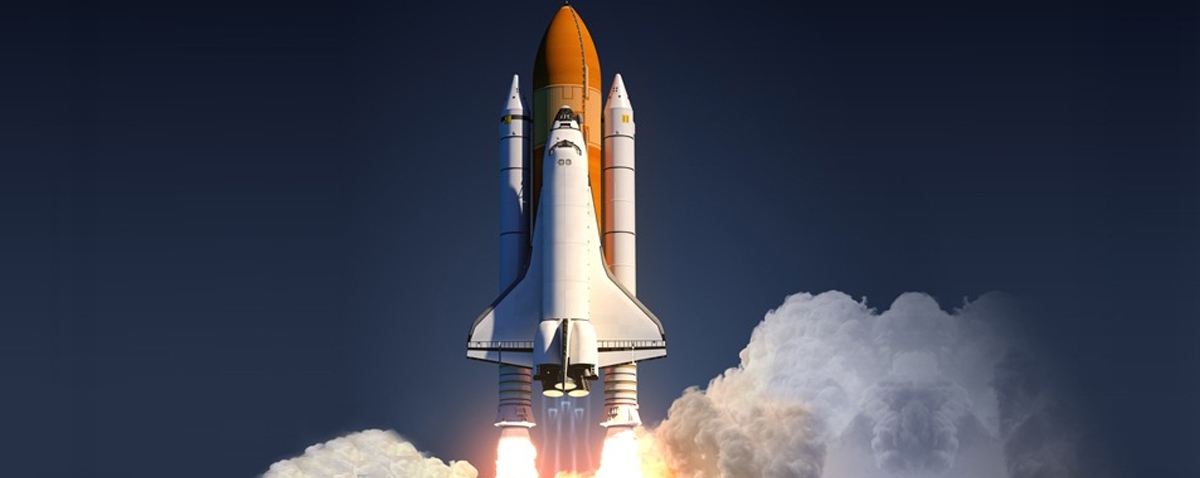
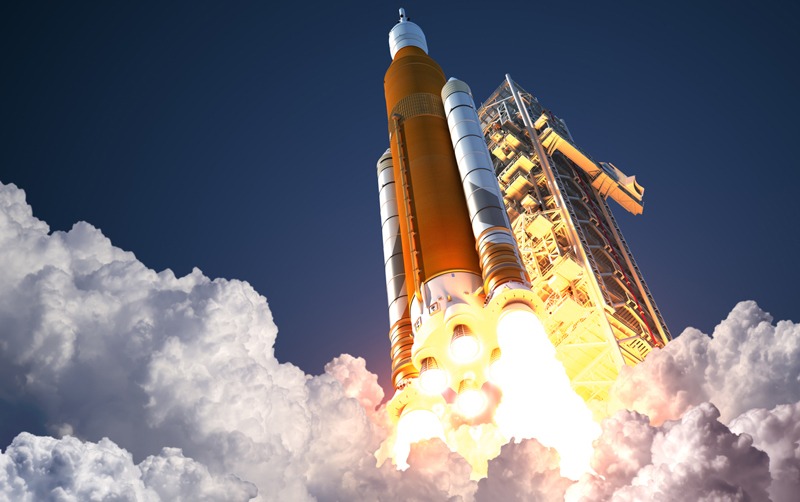
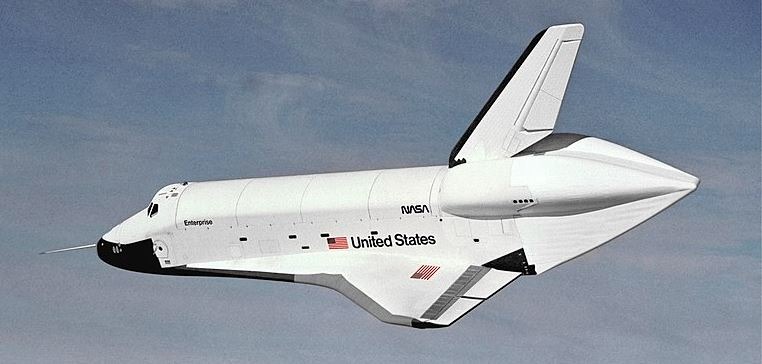
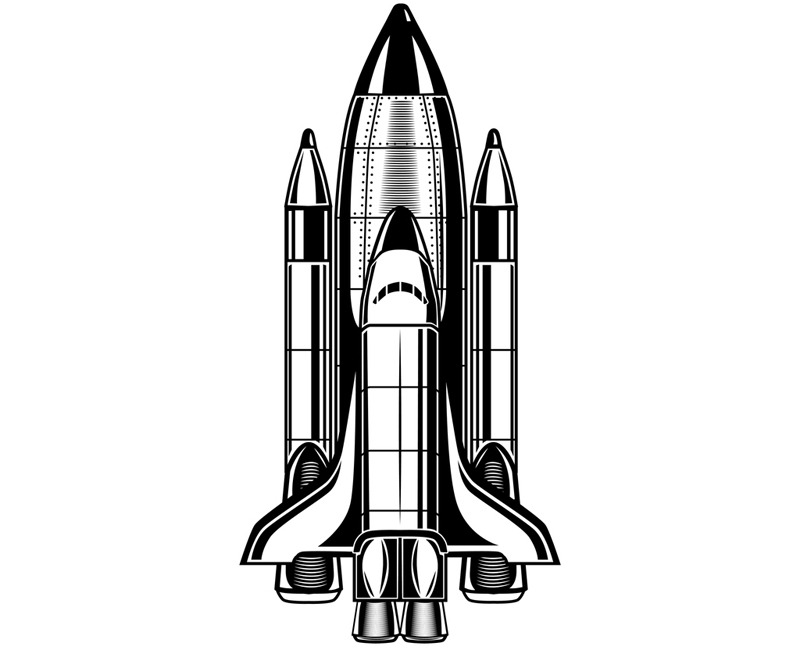
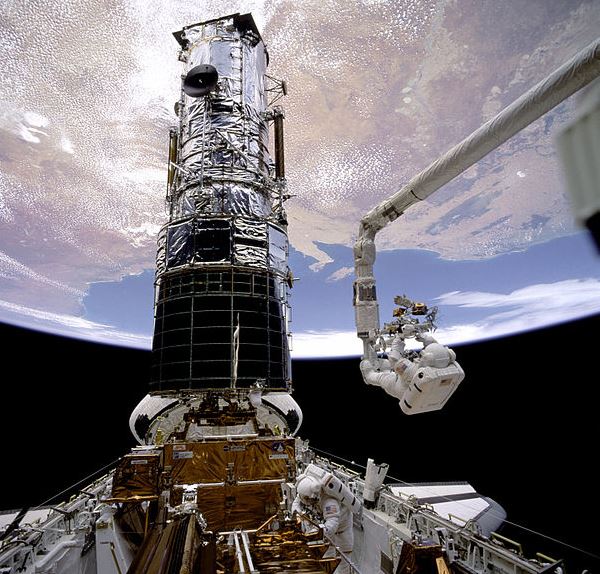
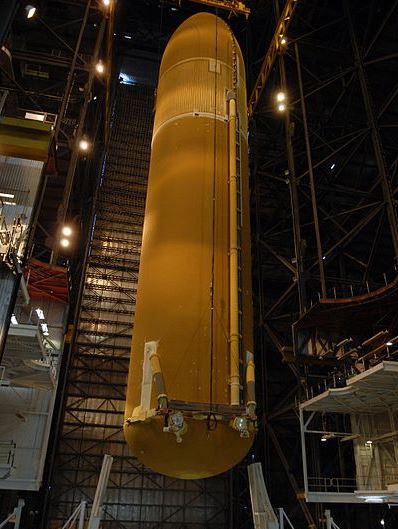
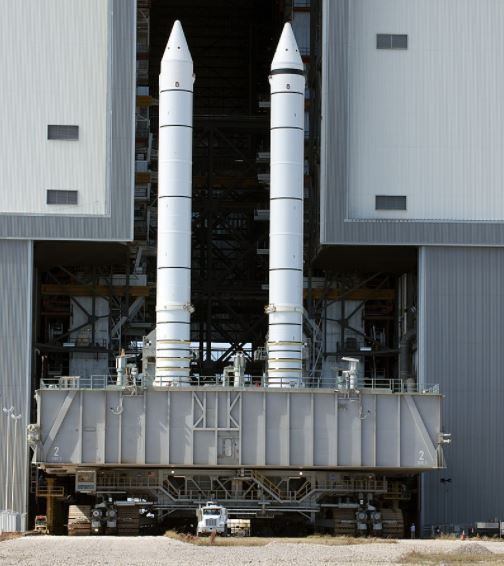
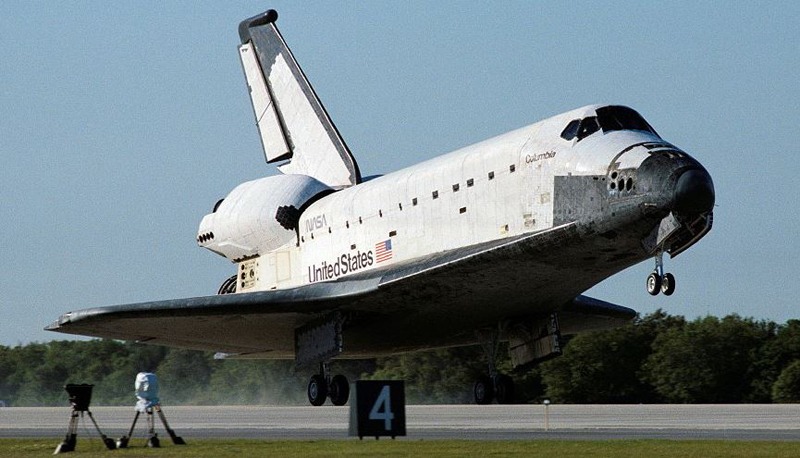

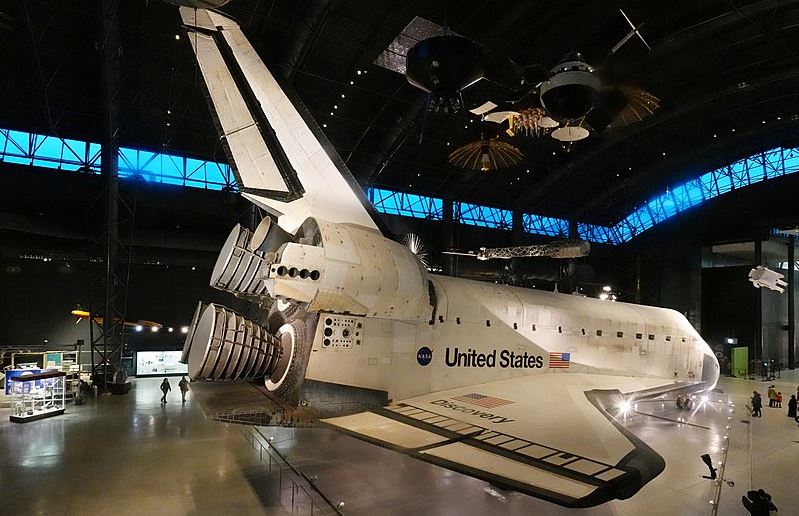


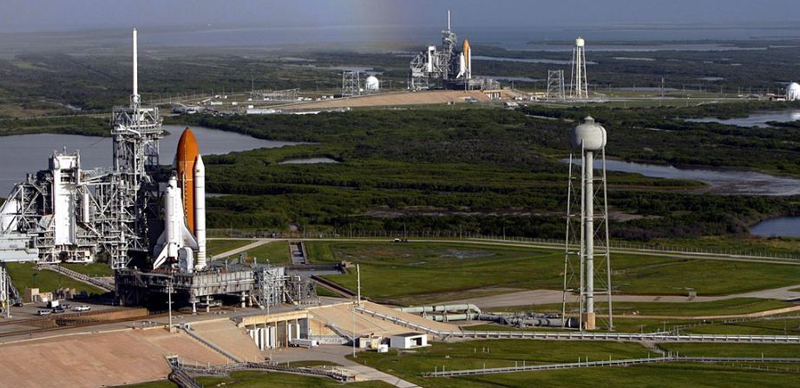
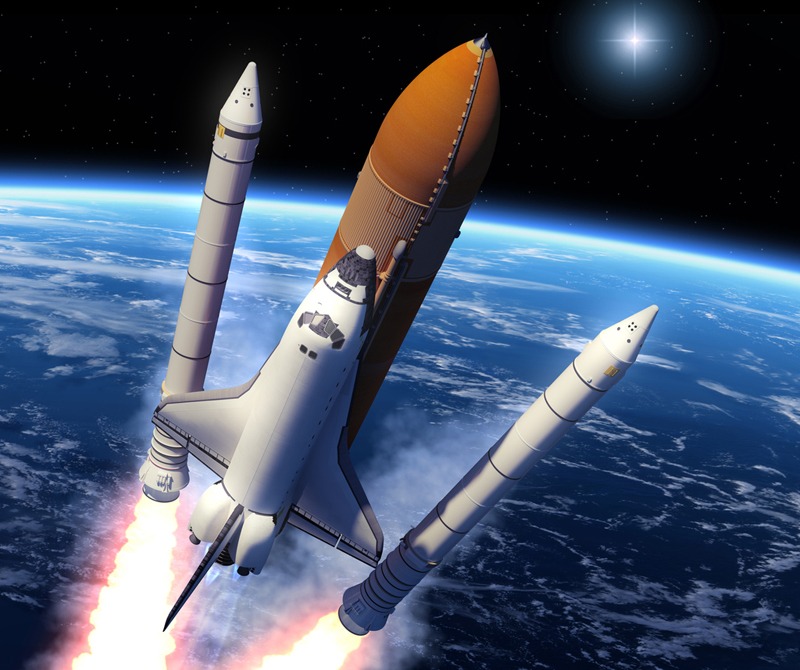
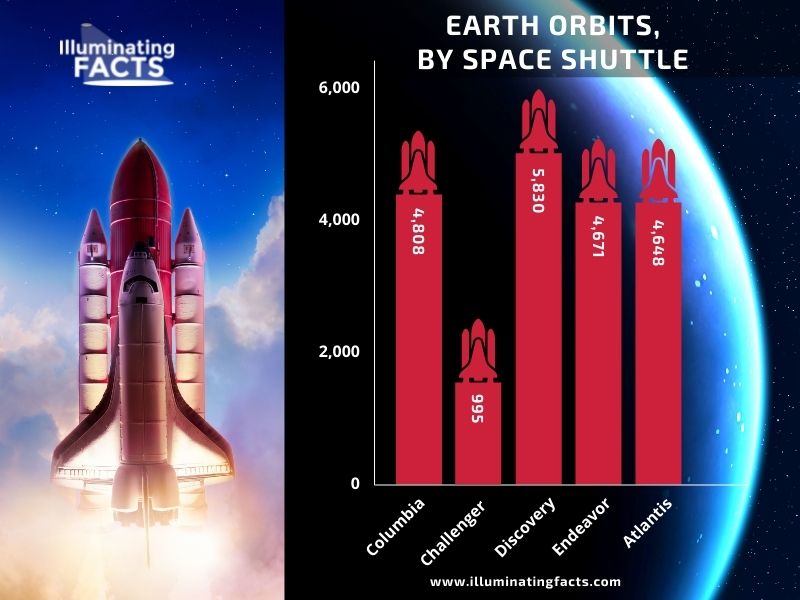
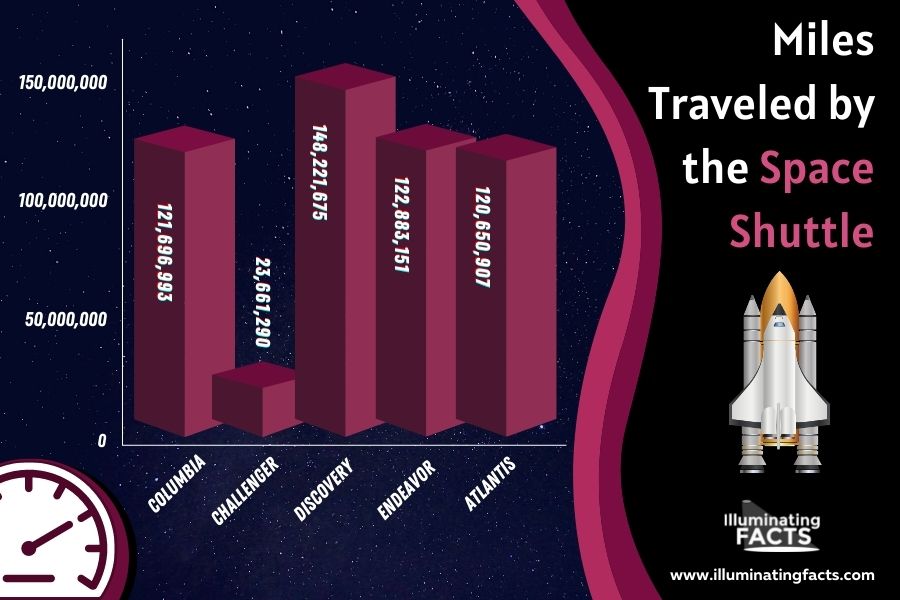

 for each Space Shuttle.jpg)
